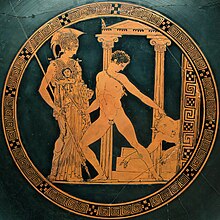
Pottery, due to its relative durability, comprises a large part of the archaeological record of ancient Greece, and since there is so much of it, it has exerted a disproportionately large influence on our understanding of Greek society. The shards of pots discarded or buried in the 1st millennium BC are still the best guide available to understand the customary life and mind of the ancient Greeks. There were several vessels produced locally for everyday and kitchen use, yet finer pottery from regions such as Attica was imported by other civilizations throughout the Mediterranean, such as the Etruscans in Italy. There were a multitude of specific regional varieties, such as the South Italian ancient Greek pottery.

Black-figure pottery painting, also known as the black-figure style or black-figure ceramic, is one of the styles of painting on antique Greek vases. It was especially common between the 7th and 5th centuries BCE, although there are specimens dating in the 2nd century BCE. Stylistically it can be distinguished from the preceding orientalizing period and the subsequent red-figure pottery style.

Red-figure pottery is a style of ancient Greek pottery in which the background of the pottery is painted black while the figures and details are left in the natural red or orange color of the clay.
The Kleophon Painter is the name given to an anonymous Athenian vase painter in the red-figure style who flourished in the mid-to-late 5th century BC. He is thus named because one of the works attributed to him bears an inscription in praise of a youth named "Kleophon". He appears to have been originally from the workshop of Polygnotos, and in turn to have taught the so-called Dinos Painter. Three vases suggest a collaboration with the Achilles Painter, while a number of black-figure works have also been attributed to him by some scholars.

A lekythos is a type of ancient Greek vessel used for storing oil, especially olive oil. It has a narrow body and one handle attached to the neck of the vessel, and is thus a narrow type of jug, with no pouring lip; the oinochoe is more like a modern jug. In the "shoulder" and "cylindrical" types which became the most common, especially the latter, the sides of the body are usually vertical by the shoulder, and there is then a sharp change of direction as the neck curves in; the base and lip are normally prominent and flared. However, there are a number of varieties, and the word seems to have been used even more widely in ancient times than by modern archeologists. They are normally in pottery, but there are also carved stone examples.

Euphronios was an ancient Greek vase painter and potter, active in Athens in the late 6th and early 5th centuries BC. As part of the so-called "Pioneer Group,", Euphronios was one of the most important artists of the red-figure technique. His works place him at the transition from Late Archaic to Early Classical art, and he is one of the first known artists in history to have signed his work.
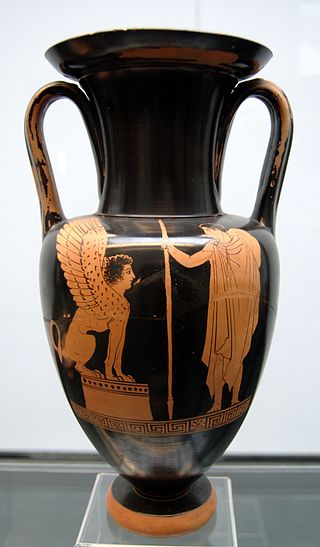
The Achilles Painter was a vase-painter active ca. 470–425 BC. His name vase is an amphora, Vatican 16571, in the Vatican museums depicting Achilles and dated 450–445 BC. An armed and armored Achilles gazes pensively to the right with one hand on his hip. The other hand holds a spear. On the opposite surface a woman performs libation.
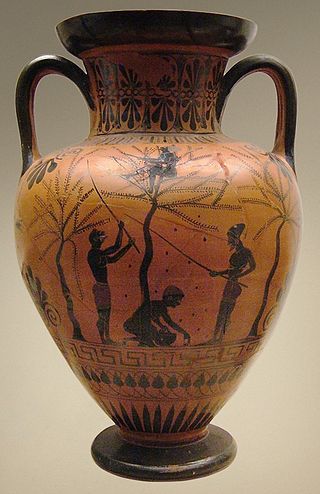
The Antimenes Painter was an Attic vase painter of the black-figure style, active between circa 530 and 510 BC.

Psiax was an Attic vase painter of the transitional period between the black-figure and red-figure styles. His works date to circa 525 to 505 BC and comprise about 60 surviving vases, two of which bear his signature. Initially he was allocated the name "Menon Painter" by John Beazley. Only later was it realised that the artist was identical with the painters signing as "Psiax".
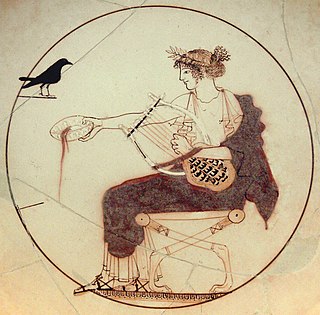
White-ground technique is a style of white ancient Greek pottery and the painting in which figures appear on a white background. It developed in the region of Attica, dated to about 500 BC. It was especially associated with vases made for ritual and funerary use, if only because the painted surface was more fragile than in the other main techniques of black-figure and red-figure vase painting. Nevertheless, a wide range of subjects are depicted.

South Italian is a designation for ancient Greek pottery fabricated in Magna Graecia largely during the 4th century BC. The fact that Greek Southern Italy produced its own red-figure pottery as early as the end of the 5th century BC was first established by Adolf Furtwaengler in 1893. Prior to that this pottery had been first designated as "Etruscan" and then as "Attic." Archaeological proof that this pottery was actually being produced in South Italy first came in 1973 when a workshop and kilns with misfirings and broken wares was first excavated at Metaponto, proving that the Amykos Painter was located there rather than in Athens.
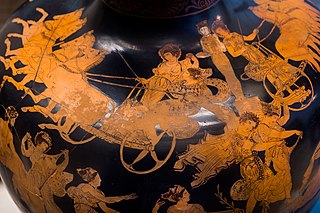
The Meidias Painter was an Athenian red-figure vase painter in Ancient Greece, active in the last quarter of the 5th century BCE. He is named after the potter whose signature is found on a large hydria of the Meidias Painter’s decoration, excavated from an Etruscan tomb. Eduard Gerhard first identified this inscription in 1839, and it was he who determined the scene on the vase was the rape of the daughters of Leukippos where previously it was thought to be the race of Hippomenes and Atalanta.

The Providence Painter is the conventional name given to a painter of the Attic red-figure style. He was active around 470 BC.

Hermonax was a Greek vase painter working in the red-figure style. He painted between c. 470 and 440 BC in Athens. Ten vases signed with the phrase "Hermonax has painted it" survive, mainly stamnoi and lekythoi. He is generally a painter of large pots, though some cups survive.

The Pan Painter was an ancient Greek vase-painter of the Attic red-figure style, probably active c. 480 to 450 BC. John Beazley attributed over 150 vases to his hand in 1912:
Cunning composition; rapid motion; quick deft draughtsmanship; strong and peculiar stylisation; a deliberate archaism, retaining old forms, but refining, refreshing, and galvanizing them; nothing noble or majestic, but grace, humour, vivacity, originality, and dramatic force: these are the qualities which mark the Boston krater, and which characterize the anonymous artist who, for the sake of convenience, may be called the 'master of the Boston Pan-vase', or, more briefly, 'the Pan-master'.

The Shuvalov Painter was an Attic vase painter of the red-figure style, active between 440 and 410 BC, i.e. in the High Classical period in Magna Graecia.

The Athena Painter was an Attic black-figure vase painter, active about 490 to 460 BC. His speciality were white-ground lekythoi painted in the black-figure style.

The Reed Painter is an anonymous Greek vase painter of white-ground lekythoi, a type of vessel for containing oil often left as grave offerings. Works are attributed to either the "Reed Painter" or his atelier.

The Taleides Painter was an Attic vase painter of the black-figure style, active in the second half of the 6th century BC. His conventional name is derived from his close cooperation with the potter Taleides, many of whose vases he painted. He also worked for the potter Timagoras.
The Codrus Painter was a Greek vase-painter of the Attic red-figure style, who flourished between 440 and 420 BC. His actual name is unknown and his conventional name is derived from his name-vase, now in Bologna, which depicts the mythical Athenian king, Codrus. He is most famous for his red-figure kylix showing the deeds of Theseus, now in the British Museum. Stylistically the Codrus Painter is close to the Aison and the Eretria Painter, and his vases have been found in three tombs with these artists.
